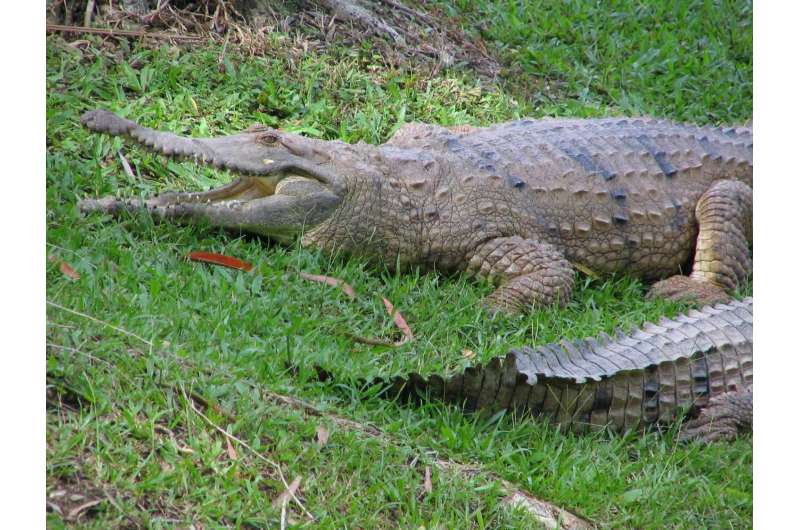May 9, 2016 weblog
Analysis of crocodile retina reveals trait that makes lying in wait easier

(Phys.org)—A team of researchers with the University of Western Australia, Crawley has discovered new details about crocodile vision that helps explain how it is they are so adept at waiting just under the water surface to capture prey that wanders too near. In their paper published in the Journal of Experimental Biology, the team describes their study of the eyeballs of both saltwater and freshwater crocodiles living in Australia, the differences between them, and a unique part of the retina they found.
Most people have seen, if only on video, the silent means by which crocodiles hunt—with their bodies just below the surface and only their eyes and part of their snout visible—they wait for prey to wander close enough to grab with their long tooth filled maws. Now, in this new effort, the researchers have found a feature of their eyes that assists them in this type of hunting; the fovea, which is an area of receptors in the back of the eyeball that are set very close to one another, and in the case of crocodiles, they are formed as a long streak, rather than as a circular spot seen in other animals. It allows, the team explains, the animal to scan the near horizon without having to move its head at all—that makes it easier to sneak up on unsuspecting animals.
The researchers report that they also found a major difference between the eyes of the saltwater crocs, versus their freshwater counterparts—the numbers of different types of photoreceptors in the retina. Freshies, as they are called, had more that were responsive to red light, whereas salties had more that were responsive to blue light. This, the team reports, makes sense because saltwater tends to have more blue light in it, while freshwater has more red in it. But, that is only a partial explanation, the team adds, because but both types of crocs have blurry vision when underwater. This, they suggest, means that the crocs do something under water that is still unknown, which is odd, because they do most of their hunting and mating on land. Both types do have the stretched fovea, they note, allowing them to lurk beneath the water without having to lift their heads, making their presence easier to mask—a feature, they report, that has not been seen in any other animal.
More information: Nicolas Nagloo et al. Spatial resolving power and spectral sensitivity of the saltwater crocodile,, and the freshwater crocodile,, The Journal of Experimental Biology (2016). DOI: 10.1242/jeb.135673
ABSTRACT
Crocodilians are apex amphibious predators that occupy a range of tropical habitats. In this study, we examined whether their semi-aquatic lifestyle and ambush hunting mode are reflected in specific adaptations in the peripheral visual system. Design-based stereology and microspectrophotometry were used to assess spatial resolving power and spectral sensitivity of saltwater (Crocodylus porosus) and freshwater crocodiles (Crocodylus johnstoni). Both species possess a foveal streak that spans the naso-temporal axis and mediates high spatial acuity across the central visual field. The saltwater crocodile and freshwater crocodile have a peak spatial resolving power of 8.8 and 8.0 cycles deg−1, respectively. Measurement of the outer segment dimensions and spectral absorbance revealed five distinct photoreceptor types consisting of three single cones, one twin cone and a rod. The three single cones (saltwater/freshwater crocodile) are violet (424/426 nm λmax), green (502/510 nm λmax) and red (546/554 nm λmax) sensitive, indicating the potential for trichromatic colour vision. The visual pigments of both members of the twin cones have the same λmax as the red-sensitive single cone and the rod has a λmax at 503/510 nm (saltwater/freshwater). The λmax values of all types of visual pigment occur at longer wavelengths in the freshwater crocodile compared with the saltwater crocodile. Given that there is a greater abundance of long wavelength light in freshwater compared with a saltwater environment, the photoreceptors would be more effective at detecting light in their respective habitats. This suggests that the visual systems of both species are adapted to the photic conditions of their respective ecological niche.
Journal information: Journal of Experimental Biology
© 2016 Phys.org



















